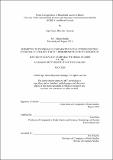| dc.contributor.advisor | Lisa Parks. | en_US |
| dc.contributor.author | Camargo, Iago Bueno Bojczuk. | en_US |
| dc.contributor.other | Massachusetts Institute of Technology. Department of Comparative Media Studies. | en_US |
| dc.date.accessioned | 2020-09-15T21:58:24Z | |
| dc.date.available | 2020-09-15T21:58:24Z | |
| dc.date.copyright | 2020 | en_US |
| dc.date.issued | 2020 | en_US |
| dc.identifier.uri | https://hdl.handle.net/1721.1/127447 | |
| dc.description | Thesis: S.M. in Comparative Media Studies, Massachusetts Institute of Technology, Department of Comparative Media Studies/Writing, May, 2020 | en_US |
| dc.description | Cataloged from the official PDF of thesis. | en_US |
| dc.description | Includes bibliographical references (pages 145-159). | en_US |
| dc.description.abstract | The launch of the Geostationary Defense and Strategic Communications Satellite (SGDC- 1) in 2017 materialized the Brazilian government's long-standing political desire to achieve national strategic communications. Representing one of the most expensive investments in the space and telecommunication sectors in 21st-century Brazil, the SGDC- 1 emerged in the public discourse not only as a high-capital and sophisticated artifact capable of fostering national pride but also as a savior of broadband Internet connectivity for Brazil's rural and remote schools. This thesis critically examines media cartographies and discourses surrounding the SGDC-1 and points out how Brazil's strategic agendas and modernization campaigns were channeled into connectivity initiatives in rural schools. | en_US |
| dc.description.abstract | By offering a humanistic approach to untangle the complex systems that enable the SGDC-1's operations throughout Brazil's territory, I unravel major points of contention in the conceptualization of rural schools as "dark spots of information" in government discourses. I then proceed to explore the government's use of the televisual as part of its strategy to frame what I call a "space-telecom propaganda." Drawing upon materials including government reports, popular press articles, datasets, court hearings, televisual texts, and satellite footprint maps, I demonstrate how the SGDC-1 functions not only as a high-technological artifact but also as a political tool interwoven with the government's efforts to shape how citizens engage with notions of the "global village" and "digital divide." Through a critical media studies approach, I describe how the satellite's sociotechnical relations reveal what remains largely obscure to Brazilian publics. | en_US |
| dc.description.abstract | From questions pertinent to militarization, governance, and public-private partnerships to issues of longterm strategies, sustainability, and potential infrastructural disruptions, I argue these issues deserve public scrutiny as the SGDC project might be at stake in the foreseeable future given the current political conditions. To mitigate those potential shortcomings, I suggest the creation of a National Internet Satellite Plan to undertake some of these questions and orient future policy frameworks that may rely on the SGDC's constellation for broadband-enabled inclusion, national integration, community development, and socioeconomic progress. | en_US |
| dc.description.statementofresponsibility | by Iago Bueno Bojczuk Camargo. | en_US |
| dc.format.extent | 159 pages | en_US |
| dc.language.iso | eng | en_US |
| dc.publisher | Massachusetts Institute of Technology | en_US |
| dc.rights | MIT theses may be protected by copyright. Please reuse MIT thesis content according to the MIT Libraries Permissions Policy, which is available through the URL provided. | en_US |
| dc.rights.uri | http://dspace.mit.edu/handle/1721.1/7582 | en_US |
| dc.subject | Comparative Media Studies. | en_US |
| dc.title | Media cartographies of broadband access in Brazil : the case of the Geostationary Defense and Strategic Communications Satellite (SGDC-1) and rural schools | en_US |
| dc.title.alternative | Case of the Geostationary Defense and Strategic Communications Satellite (SGDC-1) and rural schools | en_US |
| dc.type | Thesis | en_US |
| dc.description.degree | S.M. in Comparative Media Studies | en_US |
| dc.identifier.oclc | 1192966411 | en_US |
| dc.description.collection | S.M.inComparativeMediaStudies Massachusetts Institute of Technology, Department of Comparative Media Studies/Writing | en_US |
| dspace.imported | 2020-09-15T21:58:23Z | en_US |
| mit.thesis.degree | Master | en_US |
| mit.thesis.department | CMS | en_US |
